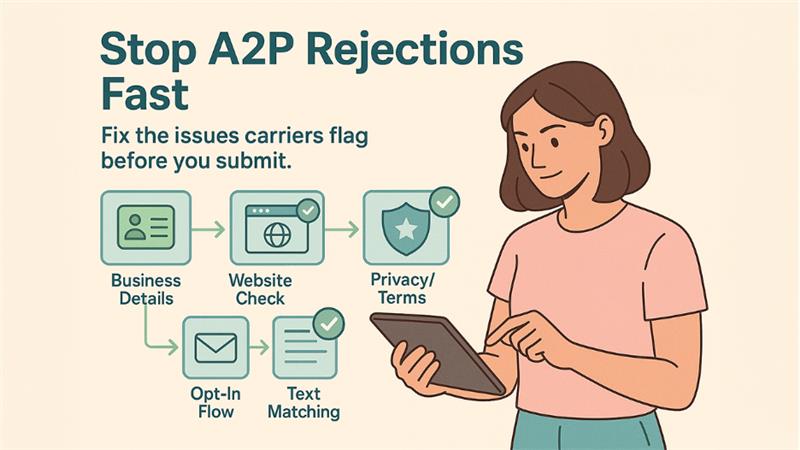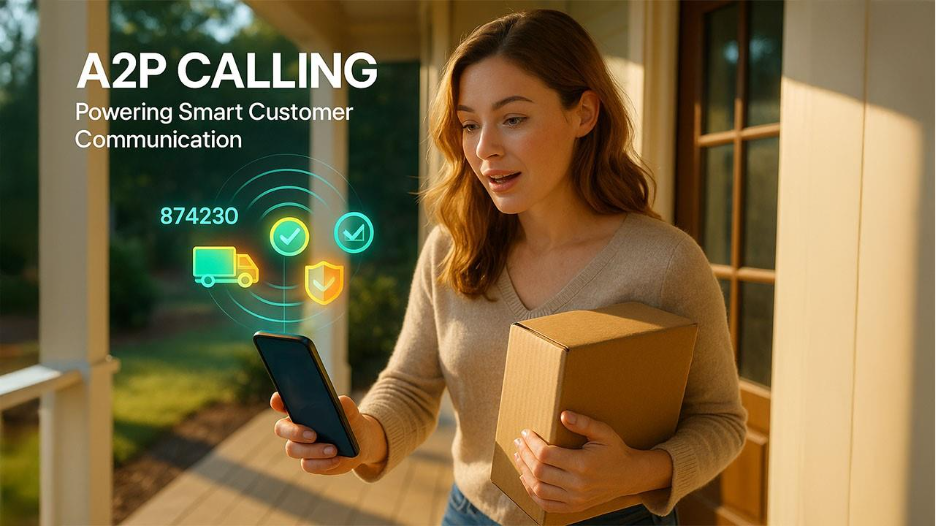In the modern world, SMS is the most preferred way of customer communication. It is an effective channel irrespective of whether you are sending OTPs, reminders, alerts, case inquiries, or
In the modern world, SMS is the most preferred way of customer communication. It is an effective channel irrespective of whether you are sending OTPs, reminders, alerts, case inquiries, or marketing updates. However, from late 2023, to send SMS messages legally in the US, businesses must complete A2P 10DLC verification. It is a mandatory process for businesses, which has been enforced by mobile carriers to avoid spam and protect users.
However, a lot of businesses have faced delays or rejections simply because of a few missing information, mismatched details, or unclear opt-in flows. In this guide, we will understand every critical factor that impacts your A2P approval and how to avoid mistakes that can prove to be costly.
Understanding A2P 10DLC Verification
A2P 10DLC verification is a compliance process through which a business registers its brand and campaign with The Campaign Registry (TCR). It is a critical process that makes sure:
- Only legit businesses send SMS traffic and that too after getting users’ consent.
- Users do not get any spam and only receive messages for which they have given their consent.
- Carriers can easily maintain quality and control spam.
Once the brand and campaign is approved, businesses get:
- Better throughput
- Higher deliverability
- Reduced filtering
- Long-term adherence to carrier rules.
Common Reasons Why A2P 10DLC Application Gets Rejected?

Most A2P rejections occur because of major issues in website, business details, opt-in flows, sample messages, etc. The biggest issue that you must be mindful of is highlighted as follows:
a) Incomplete or Incorrect Business Details
While submitting the application, it is important to make sure that your EIN, legal business name, or address matches the official/public registries. If your business is not registered or does not match the official records, carriers immediately reject your submission.
b) Issues in Website (Inaccessible, Broken, or Missing Pages)
It is important to make your website live, secure, and consistent. Essentially, the carriers check:
- Whether your domain exists or not.
- Whether there is any contact form on your website.
- Whether you have legal disclosure or whether they are publicly accessible or not.
One of the common issues is the missing legal disclosure pages, which leads to campaign rejection.
c) Missing or Unclear Opt-In Method
Opt-in method describes how the users provide consent to receive SMS messages for you. Business must demonstrate:
- Where users provide their phone numbers.
- How clear is opt-in consent text.
- How do they collect users’ permission.
Mainly, an unclear or misleading opt-in method is the main reason for rejection.
d) Missing or Incomplete Legal Pages
It is absolutely mandatory to have the following two pages publicly accessible on your website:
- Privacy Policy.
- Terms and Conditions.
Both of these pages must be compliant with A2P guidelines. Including a disclosure that no user details will be shared with the third parties is key. It is also advisable to have SMS disclosure text visible in your contact form along with links to privacy policy and terms and conditions page.
e) Mismatch of Wordings Between Website and A2P Form
Carriers closely look at the opt-in text that you have submitted, and the opt-in text that is available in your contact form. Even if there is a mismatch in a single line, your form gets rejected.
Main Factors That Affect Your A2P 10DLC Verification
The success of your verification is determined by the below-mentioned factors:
1. Brand Trust Score
This greatly depends on:
- Public business details.
- Legal registration information.
- Website consistency.
- EIN validation.
If you have a higher trust score, the chances of getting approved quickly are extremely high.
2. Quality and Transparency in Your Website
Carriers check your website manually for:
- Contact form.
- Publicly accessible legal disclosure pages.
- Clarity and transparency in your legal disclosure pages.
- SSL certificate.
- Accurate company information.
3. Clarity and Compliance in Your Contact Form:
Your contact form is one of the most critical elements that can decide whether your A2P form gets rejected or approved. It is important to ensure the following in your contact form:
- The type of message that users will get.
- Frequency of your SMS messages.
- Clear consent wordings and an opt-out option.
- Unchecked checkboxes. This is extremely important. Checkboxes should not get automatically checked. They should be checked manually by the user.
4. Clear SMS Samples
The SMS samples that you provide while filling the form must:
- Follow the TCPA rules.
- Does not have any aggressive or promotional claims.
- Avoid promotional/aggressive claims.
5. Contact Form Opt-in Consent Text
There should be an opt-in consent text at the end of your consent form. It must include specific keywords regarding consent (“you agree”), data rates (“data rates may apply”), message frequency (“message frequency may vary”), opt-out keywords (“Stop”), no obligation for purchase, etc. A sample contact opt-in text is as follows:
“By submitting this form, you agree to receive SMS messages from us. Message & data rates may apply. Message frequency may vary. Reply STOP to opt-out. Consent is not an obligation to purchase.”
What Carriers Want to See on Your Website?
Before approving your campaign, carriers manually review your website. They check for:
a) Easy-to-find and Active Form
Your contact/lead form must be accessible publicly. They should not require logins or sign-ups.
b) Clear Opt-In Disclosure
The opt-in must provide the required details and specifically must state:
- SMS-specific disclosure
- What user is agreeing to.
- Link to your terms and conditions, and privacy policy.
c) Publicly Accessible Legal Disclosure Pages
The Privacy Policy and Terms and Conditions page must satisfy the following criteria:
- There should be a visible and direct link on the contact form, linking the two pages.
- Must be accessible publicly without needing sign-ups or log-in.
- Must have data privacy disclosure.
- Must include legal business name, key business details, and contact information (email, phone number, address, etc.)
d) Brand Consistency
The name of your brand must be same across:
- A2P submission.
- Website.
- Legal disclosure pages.
Even minor inconsistencies can lead to the rejection of your form.
How to Get Your A2P Verification Fast?
Most A2P 10DLC verification and delays are easily preventable. The only thing is that one must have clear knowledge about A2P compliance requirements. Essentially, to get quick approval, you need to implement the following steps:
1. Keep the Opt-in SMS Consent Text Exactly Similar in Your A2P Form and Website
Carriers closely watch your opt-in consent text. They check it word-by-word manually.
To prevent possibilities of rejection, it is important to copy the exact text as it is displayed on your website.
2. Avoid Missing or Broken Website Pages Before Form Submission
Ensure the following things:
- All the key pages, i.e., contact form, privacy policy, and terms and conditions are live and open correctly.
- There are no “404 Not Found” issues on your website.
- All the footer links on your website are working well.
3. Include a Complete User Consent Text
Write a complete user consent text including:
- SMS consent line.
- A disclaimer for message frequency.
- STOP/HELP instructions.
4. Implement Double Opt-in
Nowadays, carriers increasingly look for a two-step opt-in process. This makes sure that users manually provide their consent two times. This allows users to re-consider their decision if they have accidentally given their consent in a contact form. Furthermore, this also ascertains that businesses only send SMS updates to users who genuinely want to receive updates.
The two-step opt-in involves the following two steps:
- Contact form submission with consent checkboxes.
- A confirmation message which requires users to reply “Yes” to continue receiving messages or “Stop” to Stop.
An example of the first confirmation message is as follows:
“Hi, [Name], thank you for your inquiry. Reply “YES” to confirm that you want to receive SMS updates regarding your request. Reply “STOP” to opt out. Reply ‘Help” for help.”
Businesses must only send messages to users only after the user has replied “Yes.”
4. Submit Non-promotional and Clear SMS samples
SMS samples must have important keywords including business legal name, users’ name, opt-out keywords (“Stop”), and assistance keywords (“Help”). It is advisable to avoid including keywords such as “guaranteed,” “free”, or “exclusive” which can raise spam flags.
5. Get Professional A2P Verification Services
Going for the A2P verification services can take a lot of time and can even lead to rejections. Thus, to avoid repeated rejections, partner with A2P specialists like OutRight Systems. We can help you with:
- Brand approval.
- Campaign approval.
- Rejection recovery & resubmission
Apart from optimizing your opt-in method, sample messages, and opt-in description, we also work on your website and make sure that your contact form is compliant, and there are legal agreement pages. We make sure that your campaign is approved within 2-5 days with full compliance and accuracy.
Conclusion
A2P 10DLC verification becomes manageable once you understand the compliance requirements and have a clear idea about carriers’ needs. A lot of businesses face rejection because of:
- Missing or broken website pages.
- Inaccessible domain.
- Missing or inaccessible legal disclosures.
- Inconsistent wording.
- Incorrect or inconsistent business details.
By making your website compliant and submitting precise details, you can greatly expedite your verification. The process looks easy only on paper, but it is actually quite tricky since even a minor mistake can lead to rejection. Thus, it is important to go for specialized services.
Respond to this article with emojis





